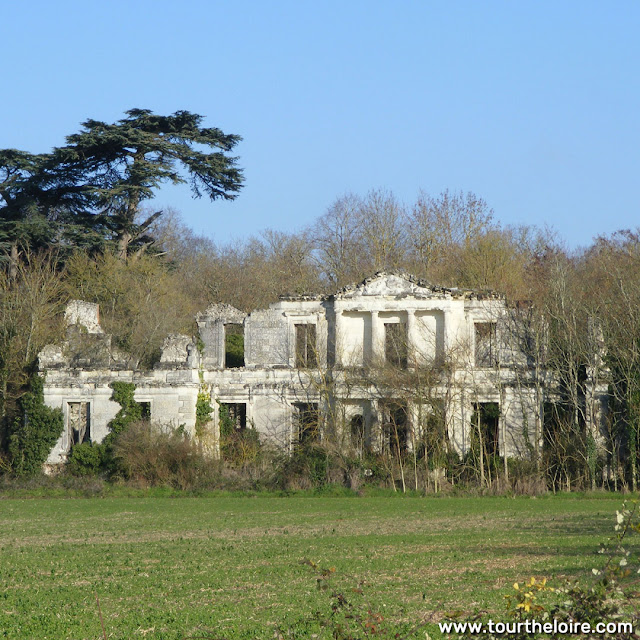The chateau of Tourballiere, a few kilometres from La Celle Saint Avant, is in fact two (or maybe three) chateau, in a row, visible from the D109 road, and all ruined. Their position looking out from the edge of the forest, and their general aspect is atmospheric and eery.
 |
| 18th century farm building to the left of the chateaux. |
Of the U or H-shaped 18th century chateau rebuilt for Paul de Murat, only the front facade survives. The side wings are long gone. The central part is deceptively well preserved, with a double colonnade topped by a crumbling pediment decorated with two lions in a coat of arms.
 |
| The ruined facade of the chateau. |
La Tourballiere is an old lordship, but we don't know anything about it until 1495, when it was in the possession of the Philippe family. At the beginning of the 18th century it was acquired by the powerful and ubiquitous Voyer d'Argenson family. In the late 18th or early 19th century their chateau was rebuilt by Paul de Murat, and the old manor remodelled.
 |
| The ruined manor house. |
The chateau was still in a good state of repair in the early 20th century, as shown by postcards of the period. After that, it seems there was a lack of maintenance, resulting in it being a ruin by the 1980s, and the gardens converted to agricultural land. [Note: there was a fire in 1930 which left it in this state.]
 |
| The ruined facade of the chateau. |
The 17th century owner was the Marquis de Chamberet, who also controlled Le Chatelier at Paulmy. In 1670 he took the local priest to court for having smashed up the family tomb in the church at La Tourballiere. The court case dragged on, but sadly the records do not reveal the outcome! The explanation for the priest's behaviour is of course that Chamberet was Protestant. His grandfather was Francois de la Noue, one of Henri IV's boon companions and known as Iron-Arm because he had lost an arm and used a metal prothesis.
 |
| The manor house. |
When Chamberet went into exile after the repeal of the Edict of Nantes it allowed Marc René Voyer d'Argenson to acquire the property. His daughter married Paul de Murat, bringing the property as dowry.
 |
| The complex as seen from the D109 roadside. |
To the left of the two chateaux is a third big building. It seems to be a farm building, in better condition than the other two, but I can't find out anything about it. [Note: it is an outbuilding associated with the 18th century chateau. The vaulted alcoves may be to shelter horses, carts or carriages.]
 |
| 18th century farm building. |
 |
| Central block of the farm building. |
 |
| The burned out chateau ruin. |
Update: On 17 March 2021 I received an email from my friend André, who passed on some information from Catherine Puglia, the guide at the Chateau des Ormes. It seems that the beginning of the 20th century the property was sold to a developer, who bought it for the land. In 1930, there was a fire which ravaged the chateau, and afterwards it was left in that state so as to avoid paying taxes on it.
Also, we now think the building on the left with the large pointed alcoves might have been a coach house. Catherine is of the opinion that the alcoves might have been to shelter horses.
She has asked that I make it clear that this is private property and unauthorised access is prohibited. The property is in a dangerous state and people should not enter and explore.
We are also on Instagram, so check us out to see a regularly updated selection of our very best photos.


5 comments:
I love all of these chateaux you've been showing. This one is pretty and sad at the same time. Driving through the French countryside I'm always surprised by a random chateau that appears on the horizon & not finding any information about it. Imagine if you had lived here and had a lovely life here and now there are trees inside.
Too bad such an interesting complex vell into disrepair.
I think the problem with this one is that it isn't a listed building. Once abandoned, there was no one to save it. I suspect the World Wars played their part too -- not directly, but in changing attitudes in the mid-20C and a redistribution or different focus for resources.
It's both fascinating and sad to see these places. While it would be nice to have them all restored I think that would be a bit too much - both for maintenance and tourists.
And disregards the fact that history didn't stop in 1560 or whatever. Buildings have timelines, and any conservation project needs to respect their whole history. Plus modern architects need to be able to practice their art.
Post a Comment